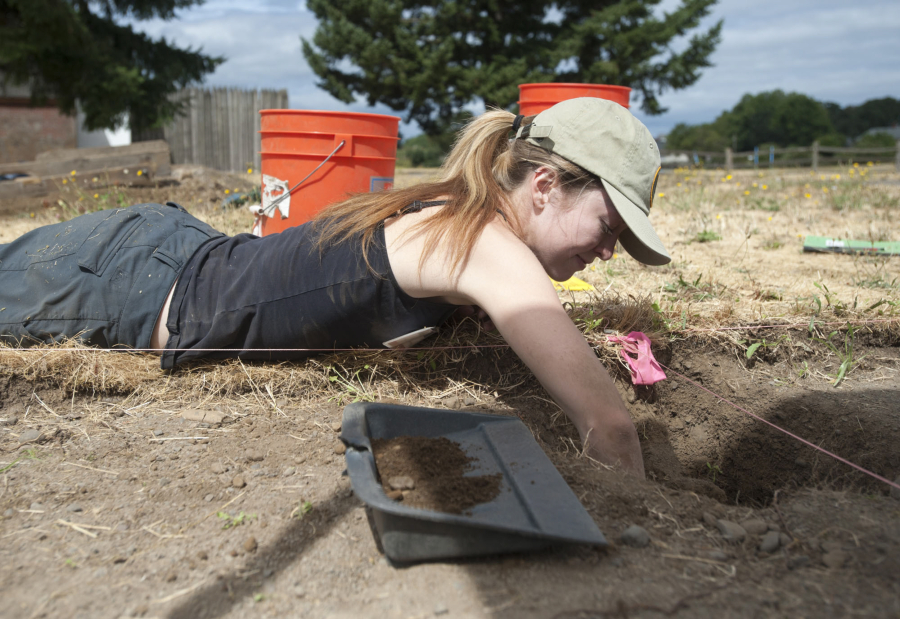The legacy of William Ryan will be explored this summer at Fort Vancouver. Archaeologists hope to learn — among other things — precisely which William Ryan they’re studying.
The excavation project in Vancouver Barracks is part of the annual archaeology program at Fort Vancouver National Historic Site. The summer program gives members of the public several free insights into archaeology in the Northwest’s most history-rich location.
The opportunities include a series of four Thursday public lectures at the Fort Vancouver Visitor Center; “Kids Dig!” children’s program on three Saturdays in July; and the annual field school, held in partnership with Washington State University and Portland State University.
The field school runs from June 27 through July 28. Tuesday through Saturday, members of the public can drop in from 9 a.m. to 4 p.m. and learn about archaeology from college students and professionals while they are excavating and documenting the dig.
If You Go
•What: Archaeological dig at Fort Vancouver’s Ryan site
•Where: Just north of the fort stockade, 1001 E. Fifth St., near the Post Exchange
• When: June 27 through July 28, 9 a.m. to 4 p.m., Tuesday through Saturday
Public field school
This year’s activity will include a spot in the lower Vancouver Barracks area, near the post exchange store, just north of the reconstructed Fort Vancouver stockade.
A building at that location is identified on an 1846 map as belonging to “Ryan.”
“There are two possible Ryans,” said Doug Wilson, National Park Service archaeologist and the project’s principal investigator.
One candidate is William Ryan, an 1845 Oregon Trail pioneer who became a prominent Vancouver resident.
The other William Ryan was a “somewhat ill-fated ship captain,” Wilson said. “His ship, the Isabella, wrecked on the bar of the Columbia River.”
The research could provide information about the fort’s transition from a fur trade post to a U.S. Army base, Wilson said.
Directions to the dig site will be available at the contact station inside the gates of the reconstructed Fort Vancouver, 1001 E. Fifth St., or at the Visitor Center.
Kids Dig!
The Kids Dig! program introduces children 8 through 12 to the world of archaeology. They will excavate a mock site with the help of student archaeologists, and discover what we can learn about the past from the artifacts buried under our feet.
The Saturday programs will take place on July 1, July 8, and July 22 at 10:30 a.m. and 2 p.m., inside the reconstructed Fort Vancouver. Space is limited to 20 children. Reserve spots by calling 360-816-6250. Go to https://go.usa.gov/xNpe4 for information.
Lectures series
Topics include archaeology of indigenous people, the fur trade and the military. All lectures will be at 7 p.m. at the Fort Vancouver Visitor Center, 1501 E. Evergreen Blvd., opposite the east end of Officers Row.
• June 29 — Training the Next Generation: Indigenous Methods in Archaeological Practice with the Confederated Tribes of the Grand Ronde Community of Oregon.
Sarah Gonzalez (University of Washington) will discuss an approach to archaeology that recognizes the rights of tribal communities in relation to their cultural heritage.
• July 13 — Recent Archaeological Research in Yellowstone National Park.
Beth Horton (archaeologist at Yellowstone National Park) will discuss the park’s rich human history that spans more than 11,000 years, represented by more than 1,800 archaeological sites. She will highlight ties between Yellowstone and Vancouver Barracks.
• July 20 — Fort Apache Pasts, Presents, Futures.
John R. Welch (associate archaeology professor at Simon Fraser University) will discuss relationships among the Apache people, soldiers, bureaucrats and advocates for cultural perpetuation, economic development and historic preservation at the Arizona heritage site.
• July 27 — Smudge Pits, Clay Pots, and Ball Courts: Understanding the Relationship Between People and Things.
James Skibo (Department of Sociology and Anthropology, Illinois State University) will describe relationships between people and things by exploring clay cooking pots, ball courts from the American Southwest and fur-trade-era smudge pits in Michigan.
Tom Vogt: 360-735-4558; www.twitter.com/col_history; tom.vogt@columbian.com




